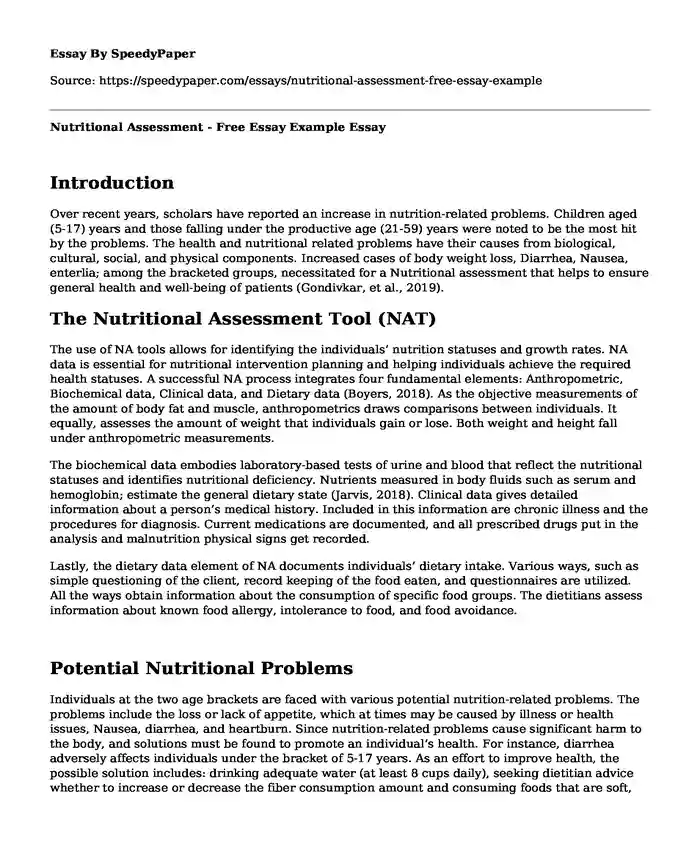
| Type of paper: | Essay |
| Categories: | Nutrition Public health |
| Pages: | 3 |
| Wordcount: | 664 words |
Introduction
Over recent years, scholars have reported an increase in nutrition-related problems. Children aged (5-17) years and those falling under the productive age (21-59) years were noted to be the most hit by the problems. The health and nutritional related problems have their causes from biological, cultural, social, and physical components. Increased cases of body weight loss, Diarrhea, Nausea, enterlia; among the bracketed groups, necessitated for a Nutritional assessment that helps to ensure general health and well-being of patients (Gondivkar, et al., 2019).
The Nutritional Assessment Tool (NAT)
The use of NA tools allows for identifying the individuals’ nutrition statuses and growth rates. NA data is essential for nutritional intervention planning and helping individuals achieve the required health statuses. A successful NA process integrates four fundamental elements: Anthropometric, Biochemical data, Clinical data, and Dietary data (Boyers, 2018). As the objective measurements of the amount of body fat and muscle, anthropometrics draws comparisons between individuals. It equally, assesses the amount of weight that individuals gain or lose. Both weight and height fall under anthropometric measurements.
The biochemical data embodies laboratory-based tests of urine and blood that reflect the nutritional statuses and identifies nutritional deficiency. Nutrients measured in body fluids such as serum and hemoglobin; estimate the general dietary state (Jarvis, 2018). Clinical data gives detailed information about a person’s medical history. Included in this information are chronic illness and the procedures for diagnosis. Current medications are documented, and all prescribed drugs put in the analysis and malnutrition physical signs get recorded.
Lastly, the dietary data element of NA documents individuals’ dietary intake. Various ways, such as simple questioning of the client, record keeping of the food eaten, and questionnaires are utilized. All the ways obtain information about the consumption of specific food groups. The dietitians assess information about known food allergy, intolerance to food, and food avoidance.
Potential Nutritional Problems
Individuals at the two age brackets are faced with various potential nutrition-related problems. The problems include the loss or lack of appetite, which at times may be caused by illness or health issues, Nausea, diarrhea, and heartburn. Since nutrition-related problems cause significant harm to the body, and solutions must be found to promote an individual’s health. For instance, diarrhea adversely affects individuals under the bracket of 5-17 years. As an effort to improve health, the possible solution includes: drinking adequate water (at least 8 cups daily), seeking dietitian advice whether to increase or decrease the fiber consumption amount and consuming foods that are soft, containing high amounts of liquid.
Heartburn and Nausea significantly challenge individuals aged (21-59) years (Fantaproject.org, 2016). Similarly, the problem needs to be addressed for health purposes. One should consider taking the last meal some hours before bedtime, taking antacid to relieve heartburn, and avoiding taking foods that caused heartburn before.
Conclusion
In conclusion, proper nutrition is a fundamental individuals’ well-being. Similarly, nutritional assessment practice is equally important. The interpretation of the information collected helps in understanding the nature and causes of health issues facing individuals. Additionally, it guides necessary interventions, thus avoiding the matter of putting individuals at adverse malnutrition related risks that are hard to take. Therefore every person should appreciate and uphold regular nutritional assessment to protect lives and general health promotion.
References
Boyers, L., (2018). Four components of Nutrition Assessment. Retrieved on: 4/8/2020. https://livehealthy.chron.com/four-components-nutrition-assessment-2449.html.
Fantaproject.org, (2016). Module 2. Nutrition Assessment and Classification. Retrieved on: 4/8/2020. https://www.fantaproject.org/sites/default/files/resources/MODULE-3-FANTA-Anthropometry-Guide-May2018.pdf.
Gondivkar, S. M., Gadbail, A. R., Gondivkar, R. S., Sarode, S. C., Sarode, G. S., Patil, S., & Awan, K. H. (2019). Nutrition and oral health. Disease-a-Month, 65(6), 147-154. Retrieved on: 4/8/2020.
https://scholar.google.com/scholar?as_ylo=2016&q=health+nutrition+problems&hl=en&as_sdt=0,5&as_vis=1.
Jarvis, C. (2018). Physical Examination and Health Assessment-Canadian E-Book. Elsevier Health Sciences. Retrieved on: 4/8/2020.
https://scholar.google.com/scholarhl=en&as_sdt=0%2C5&q=Physical+examination+and+health+assessment+&btnG.
Cite this page
Nutritional Assessment - Free Essay Example. (2023, Oct 28). Retrieved from https://speedypaper.com/essays/nutritional-assessment-free-essay-example
Request Removal
If you are the original author of this essay and no longer wish to have it published on the SpeedyPaper website, please click below to request its removal:
- Free Essay Sample on Ethical Analysis for Public Health Leaders
- Essay Sample on Prevalence of Food-Borne Infections
- Paper Example. Environmental Inequality and Justice
- Essay Example. Comparative Rhetorical Analysis
- Essay Sampel on UTI: Linked to Indwelling Urinary Catheter Use
- A Downward Spiral: A Case Study in Homelessness - Free Paper Sample
- Essay on Green Gold: Unveiling the Medical, Economic, and Comparative Aspects of Marijuana Legalization
Popular categories




